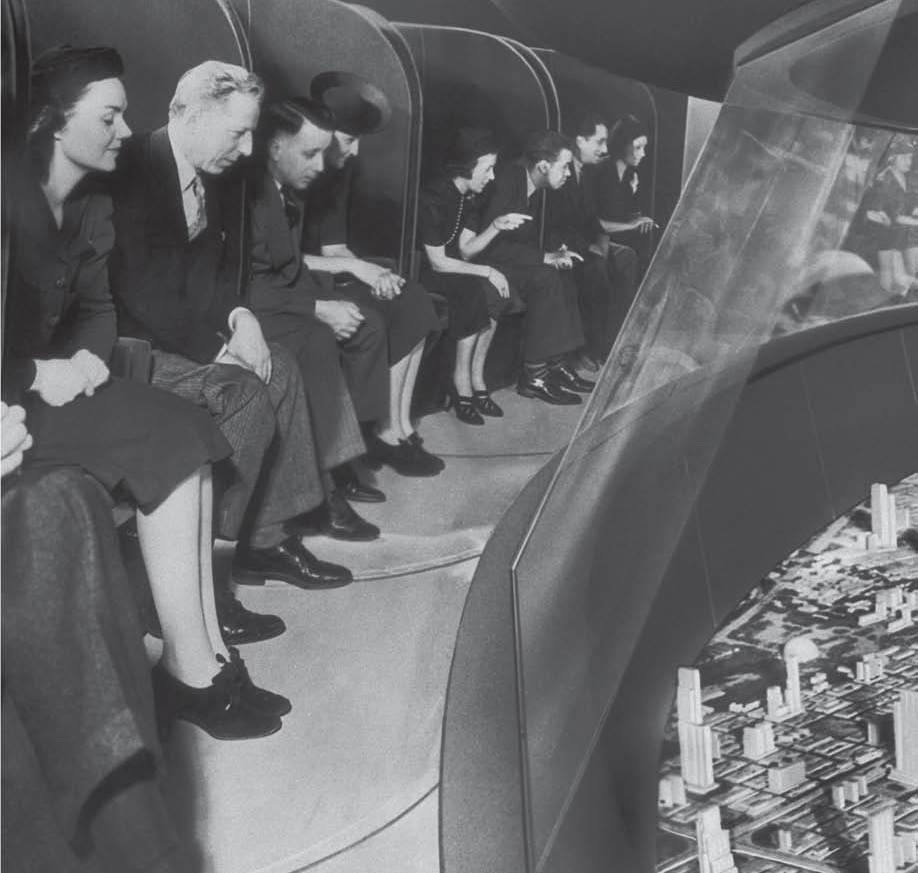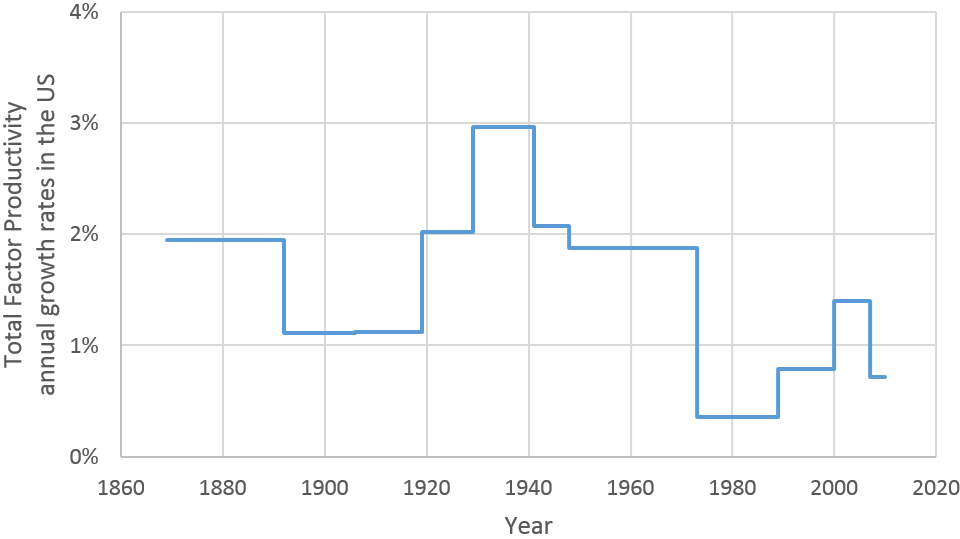 General Motors Futurama visitors
General Motors Futurama visitors
at the 1939-1940 New York World’s Fair [1]
When better ideas take over, they add more value than the sum of the capital and labor inputs
A rough measure of the technological and organizational progressivity of an era is how much more rapidly output grows than a weighted average of the growth of labor and physical capital (structures and equipment). That difference, or residual, represents the growth of total factor productivity.
This chapter examines the years 1929-41 in the United States…
…output rose very rapidly… almost entirely as the consequence of the growth of total factor productivity.

Double digit unemployment for more than a decade represented a terrible waste of human and other resources, and untold hardship for the millions of people out of work.
And yet the Depression years were also a triumph of American ingenuity, inventiveness, and hard work. What I have called the country’s Great Leap Forward…
Better ideas take over in the 1930s in processes and materials
…the 1930s were… a great age of process and materials innovations.
- The 1930s… saw the tail end of the revolution in factory layout and design that had produced such extraordinary TFP gains in manufacturing between 1919 and 1929 (over five percent per year). That revolution involved replacing systems for distributing power internally within a factory.
- Machinery became larger… …capital and operating costs per unit of output dropped when capacity increased.
- …topping techniques used the steam from high pressure boilers to heat lower pressure boilers.
- More generally, throughout industry, exhaust gasses from stacks were used to preheat air to improve combustion, preheat materials for subsequent fabrication, or generate steam…
- Improvements in thermal efficiency also benefited from attention to low cost but often high payoff investments in insulation.
- Similarly, modest investments in instrumentation yielded big efficiency gains, facilitating automatic process control, which lengthened the life of equipment, and reduced downtime and maintenance costs.
- Better treatments extended the life of wooden railroad ties from eight to twenty years.
- Stainless steel reduced oxidization on railway cars, while chrome plating lengthened the lives of tools and moving parts. Carbon steel blades had to be removed and resharpened after cutting 60 feet of plastic. A tungsten carbon alloy blade could cut 10,000 feet without refitting.
- Quick drying lacquers reduced the time needed to paint a car from more than three weeks in the early 1920s to a few hours, with consequent reductions in inventory costs.
- During the 1930s mechanical refrigerators moved from a “bleeding edge” product to a mass production and mass consumption item.
- In 1928 the Dupont Corporation lured Wallace Caruthers away from his laboratory at Harvard to Delaware, where he began to develop blockbuster new materials including neoprene and nylon. Caruthers… committed suicide in 1937…
Better ideas take over in the 1930s in transportation
The other major source… was spillovers in transportation and distribution resulting from the buildout of the surface road network.
- Railroad productivity soared, in part because of institutional and organizational changes involving freight interchange…
- …there was enough production during the Depression to replace every truck and bus on the road in 1929 at least once, and add millions more to the transportation system. These newer vehicles were, on average, larger, more powerful, and more reliable.
- …cars were much improved. Radios, heaters, and four wheel hydraulic brakes were now standard. Automatic transmission, power steering, and more powerful engines became options. Tires moved from the narrow profile high pressure products of the 1920s – reflecting the birth of the automobile in the bicycle industry, to the low pressure balloon tires upon which most of us roll today. Vehicles were streamlined and more aerodynamic, with headlights and trunks incorporated into the body rather than addons.
- In 1936 Donald Douglas introduced the DC3 – arguably the world’s most famous and successful aircraft (it had a starring role in the closing scenes of the movie Casablanca, alongside Humphrey Bogart and Claude Rains). …all US aircraft that saw major service operation in World War II were already on the drawing boards (“substantially designed”) in December of 1941…[2]
- Field, Alexander J. A great leap forward: 1930s depression and US economic growth. Yale University Press, 2011.
- Field, Alexander J. “Economic Growth and Recovery in the United States: 1919–1941.” The Great Depression of the 1930s: Lessons for Today, edited by Nicholas Crafts and Peter Fearon, Oxford University Press, 2013, pp. 358-394.